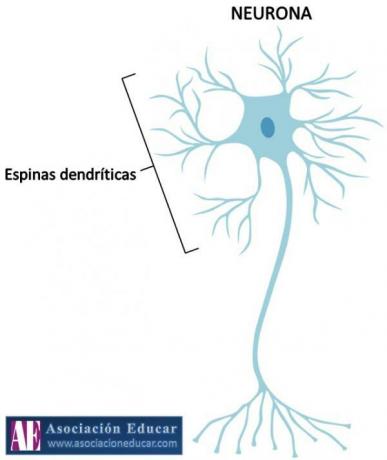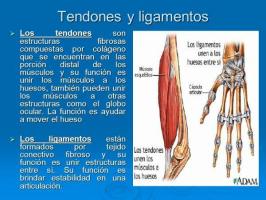Function of the DENDRITAS

Neurons are the main cells of the central nervous system. These cells, which have a high specialization in transporting information within the nervous system, have a very characteristic morphology: an elongated body, shaped like a star, with two types of prolongations: axons and dendrites.
In this lesson from a TEACHER we will review what dendrites are, dendrite function inside this cell and what happens when the dendrites
Index
- What are neurons? What are dendrites?
- What is the function of dendrites? What are dendritic spines?
- How do dendrites work?
- Dendrites and the creation of habits
What are neurons? What are dendrites?
The neurons They are cells of the nervous system specialized in capturing stimuli from the external environment and transporting and transmitting nerve impulses in the form of electrical messages. The neuron is considered the basic nervous unit of the nervous system.
Unlike other cells, the neuron does not divide or reproduce throughout life, so they cannot be responses. The neurons that we lose, we lose them forever, although normally their number remains fixed for most of our lives. It is when we are older and our body begins to age when our neurons begin to die.
A neuron is made up of a cell body or soma, is the widest part of it and contains a nucleus and cytoplasm. Neurons are well known for being star-shaped. This characteristic shape is given by its extensions. These processes or fibers can be of two types: dendrites and axon. Anatomically, the processes of neurons can be easily differentiated under the microscope.
Dendrites: definition
Dendrites are short and numerous branchesWhile the axon is a long and unique branch that can measure even meters in the longest neurons, these neurons can even reach the toes!
What is the function of dendrites? What are dendritic spines?
Like we have already said, dendrites are short and numerous branches that drive the impulse to the cell body, that is, they conduct information from outside the neuron to the body of this. Instead, the axon is a long and unique branch, which transmits this impulse from the cell body to the next neuron. Therefore, the function of dendrites is to receive information.
In turn, dendrites have numerous branches in their membrane: dendritic spines. The dendritic spines help the dendrite to carry out its function, since they are in charge of carrying out the first contact of the neurotransmitters that arrive from outside. That is, the dendritic spines act as terminals, to which the stimuli of the another neuron, which sends neurotransmitters through the space that separates them both (space synaptic).

Image: Ecured
How do dendrites work?
To carry out the transport of information, dendrites and in the neuronal body produce the electrical signals (also called action potentials) that run through neurons and end at the tips of axons.
Later, axons release chemicals to the next neuron, producing a chained transport of information called a neuronal train. When the proper amount of neurotransmitters reach the dendrites, the depolarization, which is the process that gives rise to the nerve impulse.
As you can imagine, dendrites must be very sensitive to the slightest variations in the type and amount of neurotransmitters they receive. Therefore, depending on the chemical substances that they detect, they will originate one or another pattern of Electric impulses or that an electrical signal is not generated directly, if conditions are met, that the dendrite does not depolarize and that the nerve impulse is no longer transmitted.
That means dendrites do not need to pick up any neurotransmitters so that they do not produce an electrical impulse; This can also happen if they pick up a certain amount of a certain type of chemical that gives rise to a signal such as "stop the transmission of the nerve impulse".
Dendrites and the creation of habits.
One of the most fascinating topics is how the brain is capable of creating habits, adapt to new experiences, create memories, etc. Dendrites and dendritic spines play a very important role in this.
The dendrite function is, among others, to regulate the possibilities that two nerve cells come into contact more or less frequently. So to speak, they decide the "path" the nerve impulses take: will the nerve impulse be transmitted to the neuron on the right or to the neuron on the left? Will I maintain the nerve impulse or will I cut its transmission?
But how do neurons decide? With the passage of time, the dendrites gain a certain degree of affinity with the terminals of another; This creates a common communication route, such as the paths that are created in the forests by the habitual passage of animals. This habitual communication, even if it is minimally, favors the progress of mental operations that are carried out continuously.
Furthermore, on the surface of the dendritic spines there are a number of structures called receptors. These receptors capture certain types of neurotransmitters and activate a specific mechanism, which will depend on the neurotransmitter itself. In this way, a neurotransmitter such as dopamine will reach a receptor compatible with it and will cause it to activate a process in the receptor neuron. This activation by neurotransmitters creates a series of activation routes, which favor the creation of habits.

If you want to read more articles similar to Dendrite function, we recommend that you enter our category of biology.
Bibliography
- CORDIS (23 February 2016) The importance of polarity for neurons. Recovered from: https://cordis.europa.eu/article/id/175201-neurons-where-polarity-is-crucial/es
- Instituto Superior de Neurosciencias (s.f) The neuron. Mexican Neuroscience Councils A.c. Recovered from: https://www.institutosuperiordeneurociencias.org/la-neurona
- Triglia, A (s.f) What are the dendrites of neurons? Recovered from: https://psicologiaymente.com/neurociencias/dendritas
- Valencia Segura, R. K., Colín Barenque, L., & Fortoul van der Goes, T. I. (2018). Dendritic spines, their function and some alterations. Journal of the Faculty of Medicine (Mexico), 61 (1), 46-55.



